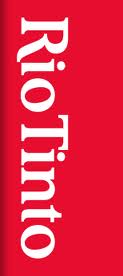 A US$2 billion extension of the Kestrel Mine was officially opened today in an onsite ceremony near Emerald in central Queensland.
A US$2 billion extension of the Kestrel Mine was officially opened today in an onsite ceremony near Emerald in central Queensland.
The extension will add 20 years to the life of the Rio Tinto managed Kestrel Mine and increase production of hard coking coal to around six million tonnes a year.
In his speech at the event, Queensland Treasurer Tim Nicholls said “Coal continues to play a vital role in the state’s economy and I welcome this long-term commitment by Rio Tinto in Queensland.
“It is yet more evidence that businesses have the confidence to invest, employ and grow here.”
The Treasurer joined Rio Tinto Energy chief executive Harry Kenyon-Slaney on an underground tour of the mine, which commenced production in July 2013.
“Today we are celebrating a long-term future for Kestrel Mine and our workforce of more than 500 employees and contractors, the relationships we have with our customers and the contributions we make to the local community and Queensland.
“A mine of this size will spend many billions of dollars in operating expenses over its life, including payments to employees, contractors and through the procurement of goods and services from other businesses who supply us.
“This extension has delivered one of the most advanced and sophisticated underground coking coal operations built in Australia.
“It is equipped with a new level of automation that will deliver significant safety and production improvements.
“I look forward to seeing Kestrel Mine continue to lead the way in improving the competitiveness of our Australian coal business while providing benefits for the state.”
Rio Tinto manages Kestrel Mine on behalf of the joint venture partners Queensland Coal Pty Limited and Mitsui Kestrel Coal Investment.
Kestrel Mine Extension facts
• Kestrel Mine has been operated by Rio Tinto since 1999.
• Construction of the Kestrel Mine Extension started in August 2008 and was fully completed in September 2013.
• It includes two declines more than a kilometre and a half long to access the new production area, a new 400 metre longwall, infrastructure such as an 8.9 kilometre overland conveyor and upgrades to the existing Coal Handling and Preparation Plant. This will allow a new series of underground panels to be mined to the south of the existing operation.
• The new operation (Kestrel South) is expected reach full capacity by the end of 2014 as the existing mine (Kestrel North) ramps down.
• It will produce around 6 million tonnes of hard coking coal per annum over the next 20 years, until around 2032.
• The extension uncovered its first glimpse of coal in July 2011 at a depth of around 250 metres.
• It has taken more than six million hours to build and more than 3400 tonnes of steel have been used, including the underground ventilation system, overland conveyor, bins and components for the Coal Handling and Preparation Plant.
• At its peak in February/March 2013, the construction of the extension provided work for around 1500 employees and contractors.
• The EL3000 Caterpillar shearer on the longwall is capable of cutting at a nameplate capacity of 5000 tonnes per hour.
• It was painted pink to symbolise a new partnership that Rio Tinto forged with the McGrath Foundation and Caterpillar to support breast care patients and their families late last year.
• Each coal train will carry 8400 tonnes of coal, travelling more than 300km from Kestrel Mine to the Port of Gladstone.
• Kestrel Mine’s main export customers are in Japan, Korea, Taiwan, Europe, India and China.
• The mine has around 115 million tonnes in coal reserves, providing options for on-going mining.
About Rio Tinto
Rio Tinto is a leading international mining group headquartered in the UK, combining Rio Tinto plc, a London and New York Stock Exchange listed company, and Rio Tinto Limited, which is listed on the Australian Securities Exchange.
Rio Tinto’s business is finding, mining, and processing mineral resources. Major products are aluminium, copper, diamonds, thermal and metallurgical coal, uranium, gold, industrial minerals (borax, titanium dioxide and salt) and iron ore. Activities span the world and are strongly represented in Australia and North America with significant businesses in Asia, Europe, Africa and South America.
